Create a drought-proof vertical garden on your fence by selecting water-efficient plants like succulents, lavender, and native grasses. Install pocket planters or rail containers with a soil mix of equal parts sand, perlite, and organic matter for ideal drainage. Use drip irrigation systems to reduce water usage by up to 70% compared to sprinklers. Group plants with similar water needs together and apply mulch to retain moisture. The right combination of plants and materials will transform your fence into a sustainable oasis.
Selecting Drought-Tolerant Plants for Vertical Fence Gardens
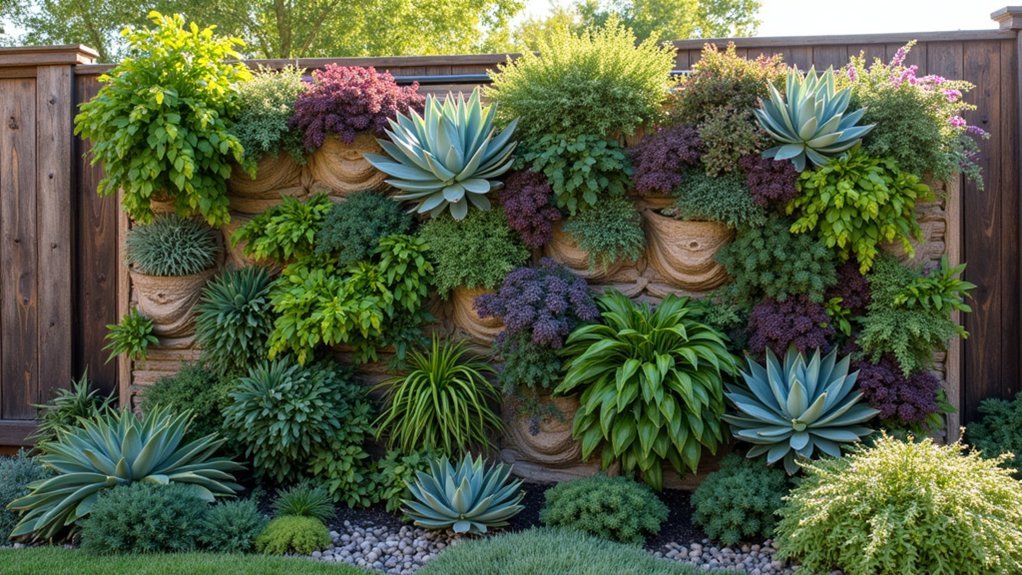
While creating a thriving vertical garden might seem challenging in arid conditions, choosing the right drought-resistant plants can transform your fence into a lush, water-efficient display.
Start with native species like succulents, lavender, and ornamental grasses that require minimal water once established in your vertical garden.
Native species like succulents, lavender, and ornamental grasses thrive with minimal water once established in vertical garden systems.
Incorporate water-storing plants such as sedum and agave, which are perfect for dry environments. For attractive coverage, add trailing plants like creeping thyme or ivy that help retain soil moisture.
Don’t overlook plants with deep root systems—desert marigold and red yucca can access water far below the surface.
For the most effective fence garden ideas, implement a layered approach mixing ground covers, medium-height perennials, and taller shrubs to maximize your vertical space while ensuring efficient water usage.
Design Principles for Water-Efficient Fence Integration
Creating a water-efficient fence garden goes beyond plant selection to thoughtful design integration. When constructing your vertical garden, position drought-resistant plants strategically, placing those with similar water needs together to prevent overwatering.
Consider your fence’s microclimate—south-facing sections may require more drought-tolerant native species than shadier areas.
- Use pocket planters or wall-mounted containers to maximize space while minimizing exposed soil surface, reducing evaporation.
- Incorporate recycled materials like untreated wood or repurposed plastic that contribute to cooler growing conditions.
- Layer your design with decorative stones or mulch to retain moisture at the root zone.
Remember that effective water-efficient vertical gardens balance aesthetics with practicality.
Irrigation Systems for Vertical Fence Gardens

Your vertical fence garden’s survival depends on efficient irrigation systems that deliver water directly to plant roots.
Drip irrigation systems offer the highest efficiency for vertical gardens, conserving up to 70% more water than traditional sprinklers while minimizing evaporation and runoff.
Pairing your drip system with automated moisture sensors allows you to monitor soil conditions in real-time, triggering irrigation only when plants truly need water rather than on a rigid schedule.
Drip Systems for Efficiency
When designing a drought-proof vertical garden, efficient irrigation becomes essential for sustainability and plant health. Drip irrigation systems deliver water directly to your plants’ root zones, reducing water usage by up to 50% compared to traditional methods.
You’ll appreciate how these systems can be customized to meet the specific needs of different plants in your vertical garden.
- Install a timer to automate watering schedules, ensuring consistent moisture even during dry periods
- Position drip emitters strategically to deliver precise amounts of water based on each plant’s requirements
- Conceal irrigation tubing within your vertical garden structure for a clean, streamlined appearance
Automated Moisture Monitoring
Taking water efficiency to the next level, automated moisture monitoring systems transform how you manage irrigation in vertical fence gardens.
These smart systems use precision sensors to detect soil moisture levels, triggering irrigation only when your plants truly need it.
You’ll appreciate the convenience of controlling your vertical garden fence’s watering schedule through smartphone apps, allowing adjustments based on real-time conditions from anywhere.
The technology delivers water directly to plant roots via drip lines or micro-sprayers, minimizing wasteful evaporation and runoff.
With integrated weather sensors, these systems automatically adjust to rainfall patterns, preventing unnecessary watering during wet periods.
The water conservation benefits are substantial—you can reduce water usage by up to 50%, saving money while maintaining healthier plants, even in drought-prone areas.
Container Options for Fence-Mounted Plant Displays
You’ll find several effective container options to establish a water-wise fence garden that maximizes vertical space.
Durable hanging pocket systems offer flexible placement for small drought-tolerant plants, while self-watering rail planters provide consistent moisture through integrated reservoirs that reduce watering frequency.
Modular grid containers create an organized display system that you can expand or reconfigure as your vertical garden evolves, allowing for strategic grouping of plants with similar water requirements.
Durable Hanging Pocket Systems
Durable hanging pocket systems provide an excellent solution for gardeners facing drought conditions while still wanting to maximize vertical growing space. You’ll find these systems constructed from UV-resistant fabric or waterproof plastic that withstand harsh weather while protecting your plants.
Their multi-pocket design makes efficient watering possible, with built-in drainage features that minimize waste during dry spells.
When selecting a system for your limited garden space, look for:
- Integrated irrigation options that deliver water directly to plant roots
- Multiple pockets to accommodate diverse plant varieties from herbs to succulents
- Reinforced hanging mechanisms that secure to fences without damaging the structure
These vertical gardening solutions transform ordinary fences into productive growing spaces, allowing you to cultivate edible or ornamental plants while enhancing your outdoor aesthetic—all without excessive water consumption.
Self-Watering Rail Planters
Self-watering rail planters represent an ingenious solution for drought-conscious gardeners seeking to maximize vertical space.
These innovative containers feature built-in reservoirs and wicking systems that draw water to your plants as needed, ensuring consistent moisture during drought conditions. You’ll water less frequently while your plants thrive with steady hydration.
Made from UV-resistant materials, these durable planters withstand harsh weather while maintaining their appearance and functionality on your fence or railing.
Their versatile design accommodates various plant types—from colorful flowers to practical herbs and even compact vegetables.
Modular Grid Containers
Versatility defines modular grid containers, which transform ordinary fences into living tapestries of drought-resistant greenery.
You’ll maximize vertical space while creating eye-catching displays that withstand harsh weather conditions. These durable systems come in various sizes and configurations, allowing you to customize arrangements that reflect your personal style while promoting water efficiency.
The built-in drainage features prevent overwatering, making these containers perfect for drought-tolerant plants like succulents and herbs.
You’ll appreciate how easily you can mix and match different modules to achieve your desired look.
- Weather-resistant materials guarantee longevity with minimal maintenance requirements
- Customizable grid systems let you reconfigure your display seasonally
- Efficient water management reduces consumption while keeping plants healthy
Soil Mixtures and Amendments for Drought Resistance
Creating the right soil foundation is perhaps the most critical factor for drought-resistant vertical gardens.
You’ll want to blend equal parts coarse sand, perlite, and organic matter to develop a soil mixture that balances drainage and moisture retention. This combination prevents waterlogging while ensuring roots access what moisture remains available.
Incorporate coconut coir or hydrogels to maximize water efficiency – these amendments hold moisture during dry spells, reducing your watering frequency.
Well-rotted compost enhances fertility and supports beneficial microbes that help plants survive drought conditions.
Don’t overlook pH levels – most drought-resistant plants thrive in slightly acidic to neutral soils (6.0-7.0).
Finally, apply a generous layer of bark or straw mulch around your plants. This simple step conserves moisture and regulates soil temperature, creating ideal conditions for your vertical garden to flourish despite water restrictions.
Installing Support Structures on Existing Fences
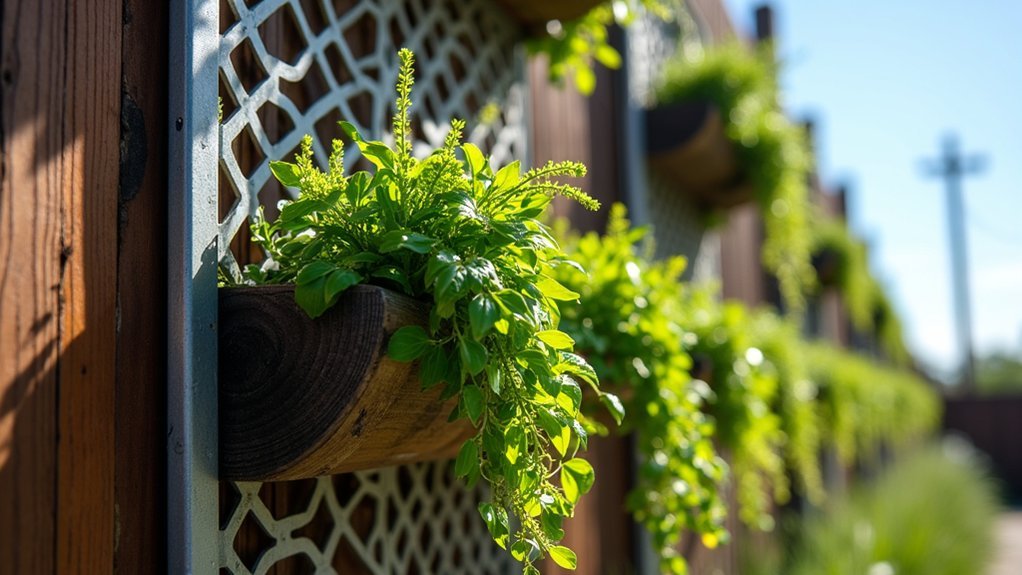
Once you’ve prepared the ideal soil mixture, the next step is securing a sturdy foundation for your vertical garden. When installing support structures, always assess if your fence can handle the added weight of plants, soil, and water. Anchor supports directly to fence posts rather than boards for maximum stability.
- Choose trellises or wire mesh that promote both climbing growth and proper drainage and airflow, preventing moisture-related issues during drought recovery periods.
- Select lightweight materials for planters and containers to reduce strain on your fence while still providing adequate growing space.
- Install specialized brackets or clips designed for vertical gardens that won’t damage your fence but will securely hold your planters in place.
Check your support structures regularly, especially after extreme weather events, to verify continued stability and safety of your drought-resistant vertical garden.
Seasonal Maintenance for Drought-Proof Vertical Gardens
Your drought-proof vertical garden requires different care throughout the year to maintain its beauty and resilience.
In spring, refresh your garden by trimming back winter damage, replacing spent soil in containers, and applying slow-release fertilizer to jumpstart healthy growth.
During winter, protect vulnerable plants by applying extra mulch, installing frost cloth for sensitive species, and reducing watering frequency to prevent root rot in cooler, less evaporative conditions.
Spring Rejuvenation Techniques
As winter fades and temperatures begin to rise, your drought-proof vertical garden needs specific attention to thrive in the upcoming growing season.
Start by pruning overgrown drought-resistant plants to stimulate new growth and improve air circulation. This simple maintenance step greatly enhances your vertical garden’s appearance while promoting water efficiency.
Apply a fresh layer of organic mulch around your plants to:
- Retain valuable moisture during warming temperatures
- Suppress spring weeds before they compete with your plants
- Regulate soil temperature as the season shifts
Replace any dead plants with seasonal drought-tolerant varieties that bloom in spring, such as colorful succulents or aromatic Mediterranean herbs.
Consider upgrading to a drip irrigation system if you haven’t already—it’s the perfect time to install one before summer heat arrives.
Winter Protection Strategies
While drought-resistant plants are typically hardy, they still require protection during the coldest months to maintain their vigor. Insulate your vertical garden structures using burlap or frost cloth to shield plants from harsh temperatures and biting winds. This simple winter protection strategy can make the difference between thriving and merely surviving.
Before winter sets in, remove any dead or dying vegetation to prevent disease and pests from making homes in your garden. Apply a thick mulch layer around plant bases to moderate soil temperature during freeze-thaw cycles.
Incorporate heat-retaining materials like stone into your design to provide natural warmth to roots. Most importantly, guarantee adequate drainage in all planters to prevent rot when temperatures fluctuate.
Waterlogged soil quickly leads to root damage that drought-resistant plants rarely recover from.
Combining Succulents and Native Plants for Visual Impact
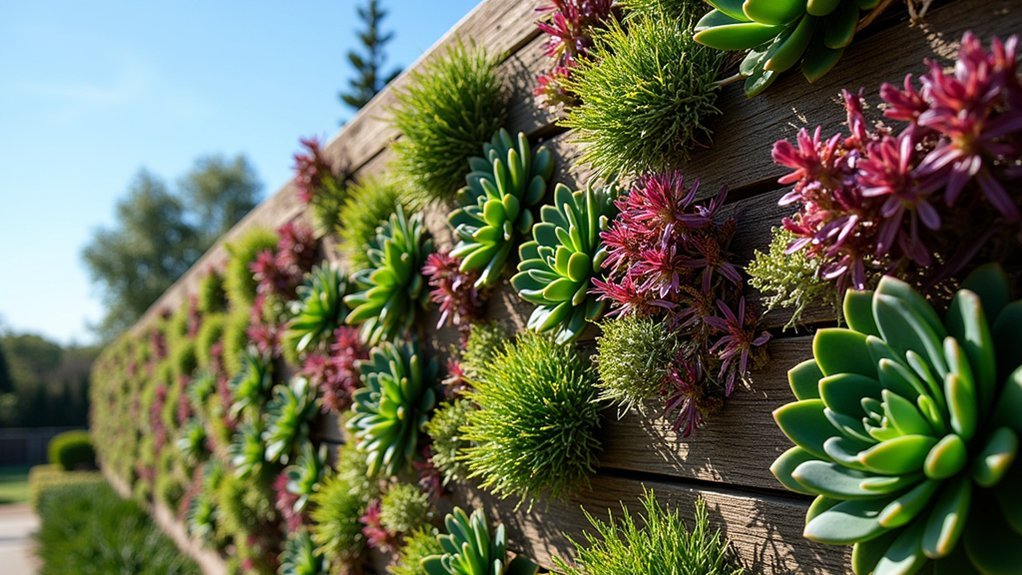
Creating visual drama in vertical gardens requires strategic plant combinations that thrive in similar conditions yet offer contrasting elements. By pairing succulents with native plants, you’ll achieve a drought-tolerant display that’s both ecologically beneficial and visually striking.
Drama in vertical gardens emerges when contrasting plants with similar needs come together, creating sustainable beauty that catches the eye.
These complementary plantings create depth through varied textures, heights, and seasonal interest while supporting local wildlife.
- Mix spiky agave or echeveria with soft-textured native grasses for compelling textural contrast
- Layer flowering natives like California poppies or lavender among succulents for seasonal color bursts
- Arrange plants in patterns that highlight color variations—silver-blue succulents against deeper green natives create natural focal points
Your vertical garden will benefit from reduced water needs while maximizing visual interest, as native plants and succulents work together to create a resilient, beautiful living wall that evolves through seasons.
Creating Microclimates Along Fence Boundaries
Fence boundaries offer untapped potential for strategic microclimate development in drought-prone gardens. By installing vertical planters and trellises against your fence, you’ll create shade zones that reduce water evaporation while maximizing growing space.
The orientation matters greatly—south-facing fences capture abundant sunlight for heat-loving drought-resistant plants, while north-facing areas support shade-tolerant varieties.
Incorporate hardscape elements like gravel or stones at fence bases to retain soil moisture and moderate temperature fluctuations. You can further enhance these microclimates by planting taller species alongside fences, creating windbreaks that protect smaller plants.
This layered approach creates diverse growing conditions within a single garden space, allowing you to match plants to their ideal microenvironments. With thoughtful planning, your fence line transforms from a mere boundary into a thriving ecosystem of drought-adapted plant communities.
Recycled Materials for Sustainable Vertical Garden Construction
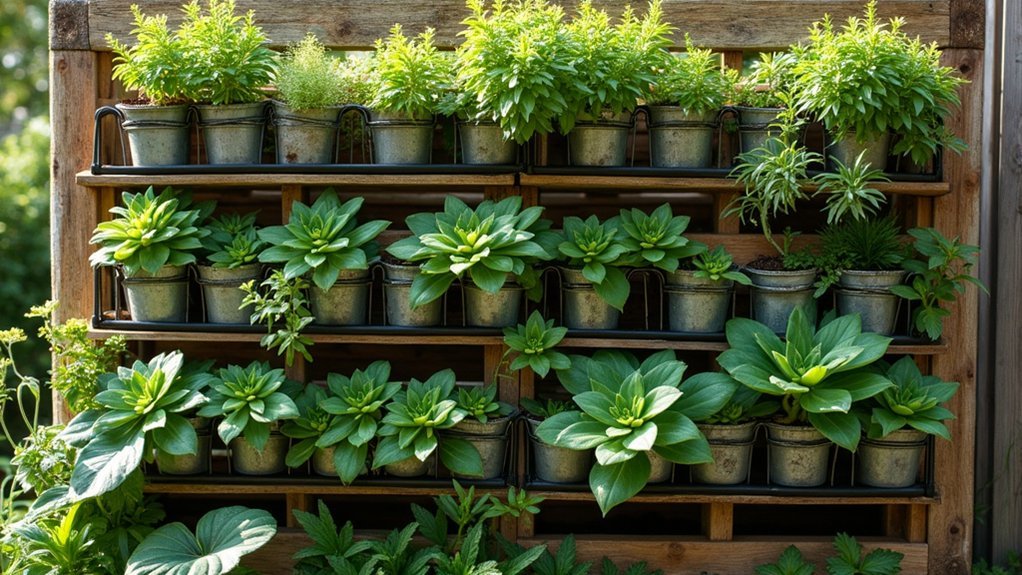
Building a vertical garden doesn’t require expensive materials or complex designs. You’ll find sustainable vertical garden options using recycled materials right in your home or local salvage yards. Transform wooden pallets into upright planters for herbs, repurpose plastic bottles as lightweight containers, or mount old gutters on your fence for salad greens and strawberries.
- Use salvaged doors and windows as decorative backdrops for climbing plants while creating protective microclimates for drought-sensitive species.
- Stack wooden crates in tiers to accommodate different plant heights, including small shrubs at the base of your vertical arrangement.
- Convert plastic bottles into self-watering planters by cutting them horizontally and inverting the top section, reducing watering frequency during dry periods.
These recycled options minimize environmental impact while maximizing growing space in limited areas.
Frequently Asked Questions
What Is the Best Low Maintenance Plant for a Fence Line?
For a low maintenance fence line, you’ll love ornamental grasses or evergreen shrubs like junipers and boxwood. They’re drought-resistant, require minimal care once established, and provide year-round visual interest with little effort.
What Is the Cheapest Alternative to Fencing?
You’ll find bamboo screens extremely cost-effective at just $1 per linear foot. Recycled pallets offer another budget option at under $50 for 20 feet. Don’t overlook chain link ($5-15/foot) or DIY natural materials.
What Can I Build Instead of a Fence?
You can build living barriers using succulents or native shrubs, vertical gardens from recycled materials, decorative trellises with climbing plants, stone or brick walls, or a series of raised garden beds along your property line.
How to Build a Garden Fence to Keep Animals Out?
You’ll need a 6-foot tall fence with wire mesh or metal panels. Bury it 6-12 inches underground to prevent digging. Install a gate with secure locks and inspect regularly for damage.
In Summary
You’ve now got all the tools to create your own drought-proof vertical garden fence. By combining water-wise plants, efficient irrigation, proper containers, and the right soil mix, you’ll enjoy a sustainable outdoor feature that thrives in dry conditions. Remember to adjust your maintenance with the seasons and consider microclimates along your fence line. Your beautiful vertical garden will conserve water while transforming your outdoor space.

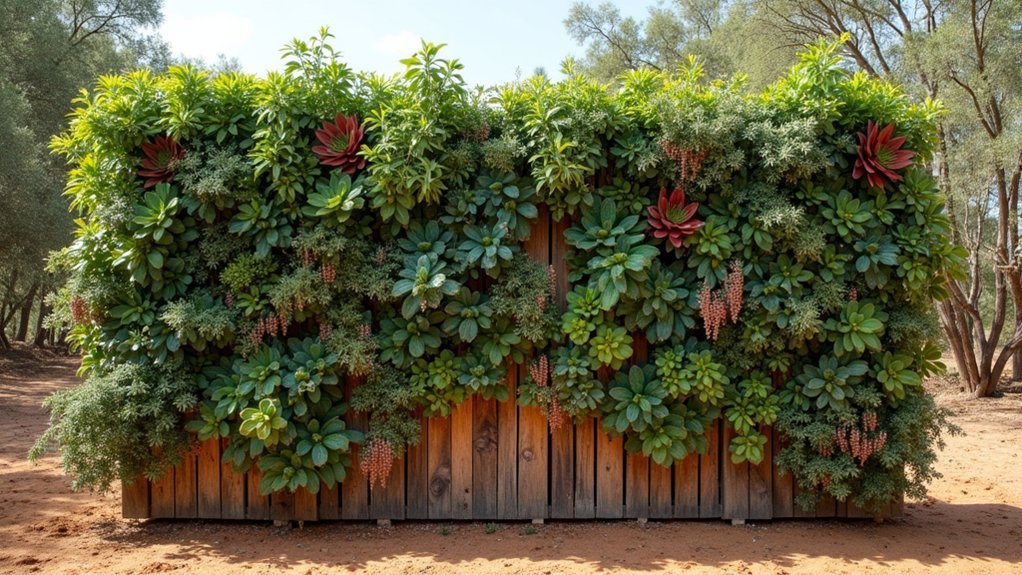



Leave a Reply